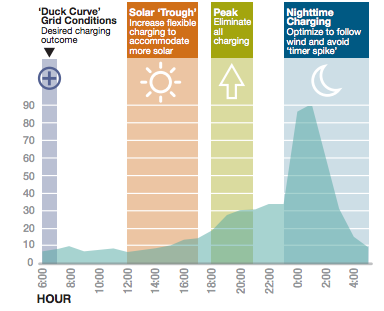Delivering electricity to consumers and businesses during peak demand periods is an ongoing challenge for utilities. Most utilities already have demand response programs in place that use time-based rates or other financial incentives to encourage consumers to reduce or shift their electricity usage during peak periods of demand on the power grid.
Electric vehicles can play a key role in this demand response capacity and have already been proven effective in a pilot program involving the utility PG&E, BMW and nearly 100 San Francisco Bay Area owners of BMW’s i3. The “smart charging” program utilized a battery storage system made of used EV batteries, the i3 vehicles and advanced software programs to determine when the plugged in i3s would be charged in response to higher or lower demand on the grid. (For more detail, read the entire PG& E/BMW smart charging report)
“We were able to use that (production telematics system) to execute grid event signals from the utility and send them to vehicles and get them to perform. So from our perspective, for demand response events and those types of use cases, vehicles are ready right now and can be a really valuable resource to utilities.” – Adam Langton, energy services manager for BMW North America
Pilot vehicle to grid (V2G) programs like this one between a utility, automaker and owners of EVs are providing a glimpse of the future of EVs as more than just vehicles for transportation, but as flexible and mobile energy storage devices.
Growing Excess Clean Energy Versus Peak Energy Demand Challenge
Adoption of V2G programs in the future will be increasingly driven by the generation of too much clean energy. This is becoming a growing challenge for utilities and regional grid operators, especially in areas like California, where wind and especially solar-generated electricity sources have increased dramatically in recent years.
(See related EVAdoption article: The Future of Electric Vehicles: Mobile Energy Storage Devices)
The production of solar and wind power fluctuates throughout the year and during the day (solar obviously stops producing when the sun goes down) and residential and commercial use also fluctuates greatly in a 24 hour period and during different times of the year. The result is a growing challenge of trying to manage these production and consumption fluctuations so that they are better synchronized.
As this Los Angeles Times article outlines in great detail, there are times when the regional grid operator known as the California Independent System Operator (CAISO) has to pay the Arizona grid operator to take California’s excess energy that is produced during certain times of the year and day. And while many are banking on a future of utility-scale battery storage and systems such as Tesla’s Powerpack solution, electric vehicles could ultimately provide a more scalable and economic solution to the production/demand challenge.
What gives EV battery storage increased value over a stationary storage battery is its mobility, its ability to tap into excess clean energy closer to the source (workplace, schools, malls, etc) where the infrastructure can be put in place to capture a huge supply of electricity and then transfer that excess power to a parking lot full of EVs. Those EVs can then individually transfer that stored power to other locations, primary the owner’s home and distribute it back to grid locally and when and where it is needed during peak demand.
This short video from Mobility House explains how a vehicle to grid system works.
Utilities benefit greatly from the use of V2G capabilities and EV battery storage as it reduces the need to build new peaker power plants, invest in massive battery storage systems and to have to pay other grid operators to take their excess clean energy.
“The cool thing about it is there’s a win-win. You’ve got a win for the customers, because they’re going to get a value off of [these grid services]. […] Then there’s a win for the utility, because we’re better managing the grid, which is becoming increasingly important as the grid is changing.”
“I think there’s an additional win too, because this helps to support these larger policy goals of not just decarbonizing transportation, but decarbonizing the grid. If you have a more flexible resource, then you’re able to allow for more renewable generation moving forward. So it’s a win-win-win.” – David Almeida, electric vehicle program manager at PG&E (via GreenTechMedia)
 Announcing the acquisition of EVAdoption by Paren →
Announcing the acquisition of EVAdoption by Paren →

2 Responses